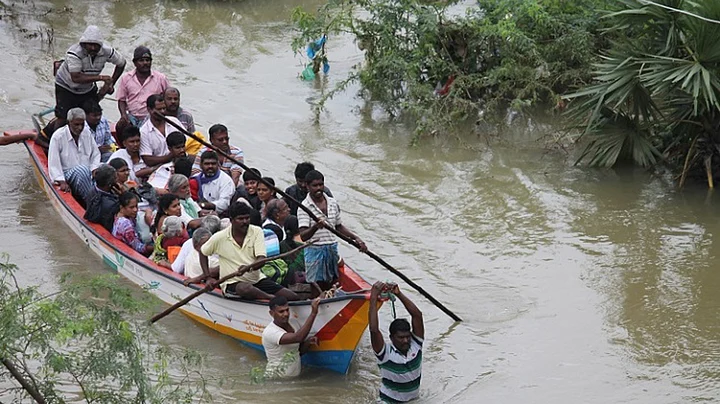As dawn breaks and we enter Tamil Nadu from Karnataka on Thursday morning, it is hard to believe that the state is witnessing its biggest natural calamity since the 2004 tsunami. Driving through Vellore, the roads are wet, but not flooded and the skies are clear. In and around Vellore and even by the banks of Palar, there is no indication of the deluge.
It’s when we enter Kanchipuram that we see tell-tale signs of the massive floods and how bad the situation was just the previous day. Water is flowing over bridges like never before in the recent memory. The ground-floor of houses are completely submerged. Fishermen are operating boats on the streets. Fields are inundated. Rescue workers are working at a hectic pace.
Inundated Villages
By the time the Palar River flows from Vellore to Kanchipuram, it gathers speed, bulldozing bridges and the vehicles plying on them. But amidst all this, Kanchipuram is up and about.
Our first stop was at the Walajabad Bridge which runs across the Palar in Kanchipuram, linking about 25 villages like Thammanur and Melkondai to the main town of Walajabad. Water was flowing over the bridge at a dangerous pace, rendering it inoperative. The bridge on the other side of the island with these villages had collapsed on Tuesday. This meant that all the 25-odd villages were now cut off from the mainland.
As if nature’s fury and government apathy weren’t enough, the recklessness of the people and their lack of awareness added to their woes.
Not very far from the Walajabad Bridge is Lord Venkateshwara College. On Wednesday, three youngsters, Bharat, Alex and Viji – a grade 10 student, an ITI student and a young professional respectively – decided it was a good idea to go to the bridge behind the college and take a selfie as the water flowed over it with strong currents. As they were taking selfies, they slipped and fell into the Palar. For four hours, rescue operations were underway to find them, and they were finally found on a small sandbar few kilometres downstream, holding on to each other, and their own lives.
Our next stop was at Mahalakshmi Nagar, near Chengalpettu. Several decades ago, the agricultural lands in the area were converted to residential areas for cooperative society, and plots sold based on a lottery system. Those fields became Mahalakshmi Nagar – a bustling colony of about 350-400 homes and a couple of thousand residents. They were all stuck there after the rains on Tuesday and Wednesday.
Surprisingly, there were at least a 100 people in the colony who were refusing to get out. They believed that the water will not rise further and recede in a day or two.
“We have all the food we need, we will stay here till water goes away,” a lady shouted back when I asked her why she was not being evacuated.
“At least you tell them, it is not safe here, but we cannot force them,” a rescue worker on the boat told me.
An award for recklessness would have, however, gone to those who chose to be inside the inundated colony, and swim in the waters for fun. Two kids and an adult were seen using an abandoned bed to float on the water, right next to thorny trees and electric poles. Visibly angry at them, rescue workers forced them back inside their homes.
A common sight across Kanchipuram, however, was that people lined up near bridges to witness the water bodies in all their glory. “I have never seen so much water here in my life,” exclaimed a fisherman as he made his way to the Uthiramerur Lake.
Just a few days ago, the lake was absolutely dry. Now it has nearly 1,000 cusecs of water according to local officials, and families and kids were lining up across the bridge over it to take selfies.
(At The Quint, we question everything. Play an active role in shaping our journalism by becoming a member today.)
